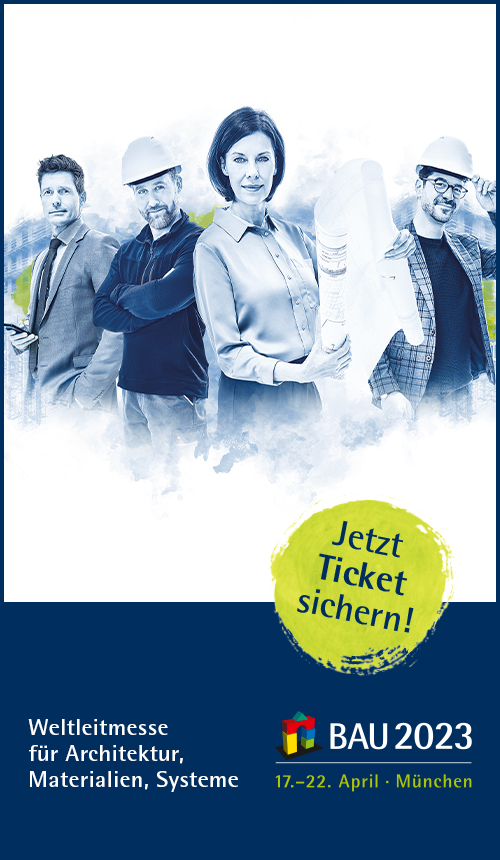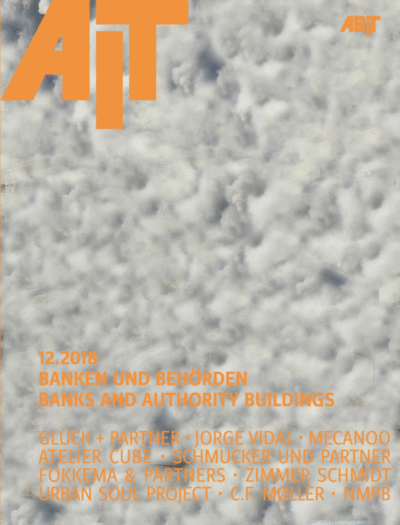
2018

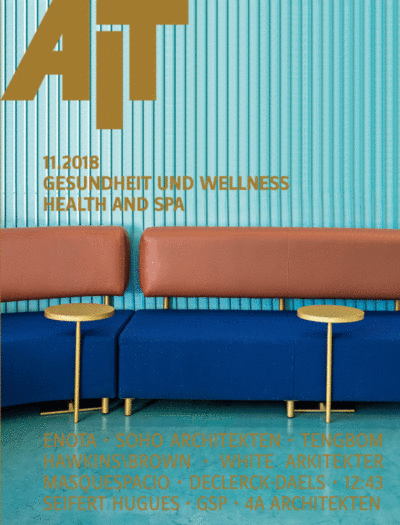
E-Paper Ausgabe 11 | 2018
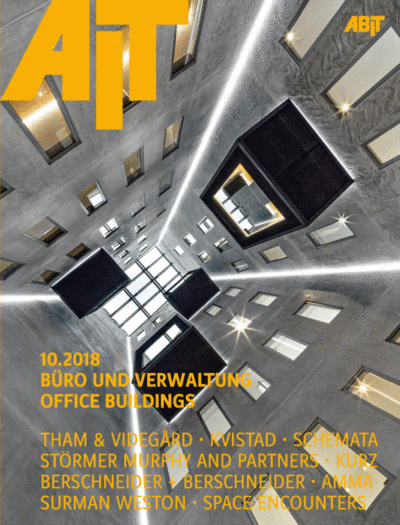
E-Paper Ausgabe 10 | 2018
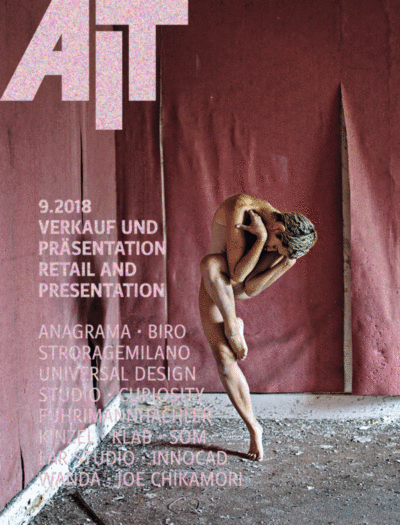
E-Paper Ausgabe 09 | 2018
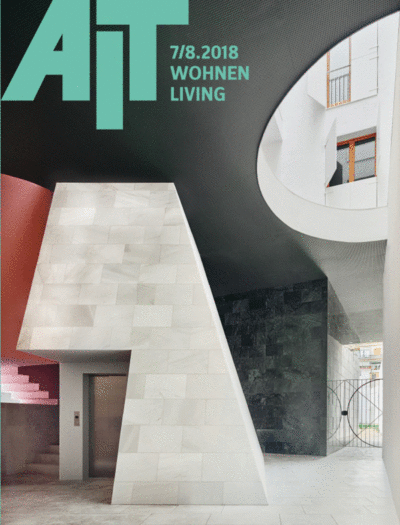
E-Paper Ausgabe 07/08 | 2018

E-Paper Ausgabe 06 | 2018
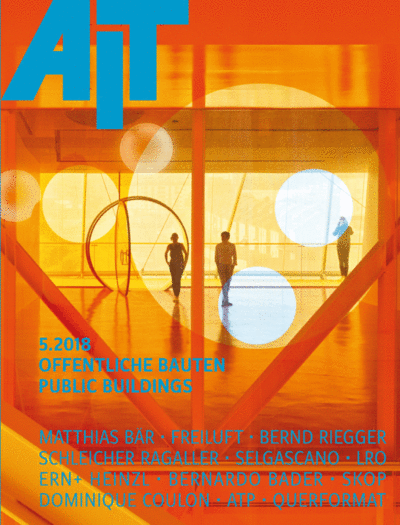
E-Paper Ausgabe 05 | 2018

E-Paper Ausgabe 04 | 2018
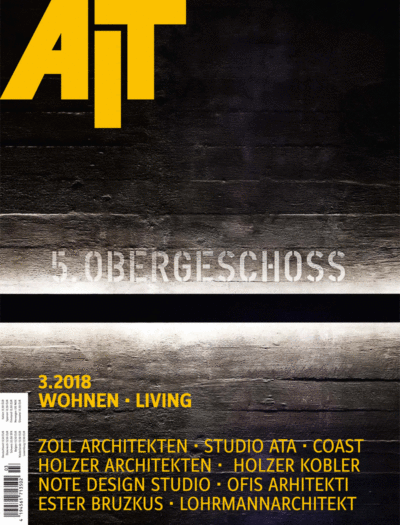
E-Paper Ausgabe 03 | 2018
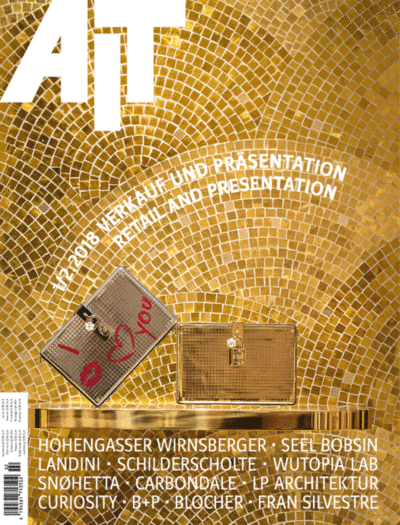
E-Paper Ausgabe 01/02 | 2018

Issue 12 | 2018
BANKS AND AUTHORITY BUILDINGS
Dear Readers,
a year of biennials is coming to a close! Whether the Architecture Biennale in Venice, the Biennale Interieur in Kortrijk, Orgatec in Cologne or Designers´ Saturday in Langenthal – it feels as if twice as many events take place in even years as in odd years. Yet, the AIT editorial staff can also look back upon a successful year: our highlight surely was the award as Best Trade Journal of 2018, which we celebrated in Berlin in May and in Stuttgart in October! The last time we celebrated was at Orgatec! Before that, we had to search the exhibition halls in Cologne to find new products worth mentioning in the office furniture sector. Our large trade fair follow-up report on page 32 features our findings. Those of you who are currently designing a bank or an authority will certainly find what they are looking for, because the trends in the office furniture sector towards mobility, flexibility and unconventional
forms of communication reflect the developments in this sector. This is evident in the project selection for this AIT issue on “Banks and Authorities”: In times of digitalisation, institutions that were so far characterised by services at the counter need a completely different internal layout and furnishing in order to be able to provide uptodate advisory services. We report on these new challenges in the article “Zukunftsmusik” starting on page 144. The fact that Christmas is just around the corner is by no means a dream of the future. To reduce the annual stress of finding presents, we have compiled some gift ideas especially for (interior) architects on page 169. As we also want to give something to our loyal readers, there is – as every year – our AIT Christmas raffle! On page 98 you can find out what to expect if you send us an e-mail with your address to weihnachten@ait-online.de by 14 December. We would like to thank you for your kind support in the past year, and wish you and your families a relaxing Christmas season and a magnificent 2019!
Best Wishes
Petra Stephan, Dipl.-Ing.
Chief Editor
Architect

Issue 11 | 2018
HEALTH AND SPA
Dear Readers,
it is a justified demand that hospitals and medical practices must not only perfectly serve the practicing physicians and nurses in technical and functional regard, but also actively support the patients on their way of recovery. For this AIT issue on health and wellness, we have found numerous projects (starting on page 84) that can do even more: improve the infrastructure, resolve an urban planning situation or even act as a conference venue for the Nobel Prize Committee for Medicine. This happened only recently in the Aula Medica lecture hall complex designed by Wingardh Arkitektkontor (top picture). It is part of the renowned Karolinska Ins titute in Solna near Stockholm; since last May, it has a new coun terpart, the Karolinska Uni versity Hospital (page 106) based on a design by White Arkitekter. Here, excellent interior design as well as elaborate art installations have a positive effect on the patients. How ever, it is best not to get sick in the first place — easily said at the beginning of the annual flu season. Prevention may be enhanced by the swimming
pools and spa facilities we have put together starting on page 112. To help you plan and equip such facilities, you can take a look at Italian tile innovations we found at the Cersaie trade fair in Bologna on page 32 and a summary of the latest panel and wood materials on page 70. We used the last sunny days of the year to fly to Portugal with a group of selected interior designers (pictures on the right) to determine the INsider 2018. In addition to in sights into Portuguese interior design and architecture, the focus was on the personal interior design approaches of the participants, and they chose the winners from their own ranks: Moritz Köhler, Studio Komo in Stuttgart (1st place); Georg Thiersch, eins:33 in Munich (2nd place), and Annika Wagener, Esteht in Hanover (3rd place) were very pleased with their colleagues’ appreciation. As every year, we welcome all freshmen of in terior design and architecture with the AIT Welcome Package. Simply send your postal address and your enrolment certificate to pstephan@ait-online.de and/or spread the word!
Best Wishes
Petra Stephan, Dipl.-Ing.
Chief Editor
Architect

Issue 10 | 2018
OFIICE BUILDINGS
Dear Readers,
supposedly there are people who think the topic of offices is boring and dry as dust. But we know better. During the preparation for this issue on offices and administration buildings, we were once again able to see for ourselves how diverse the international office landscape is. We have compiled a wide variety of office concepts and solutions for you — from small advertising agencies in the Czech Republic or the business incubator in Archena, Spain, to co-working spaces in London and Stockholm, headquarters in Oslo and Amsterdam, to new office buildings in Hamburg and Lupburg that have a strong influence on the cityscape. In the rarest of cases we have the opportunity to take a look at the lively office scene and, of course, we know: An office environment only looks tidy and perfectly staged for an appointment with the photographer. So, it was all the more interesting for me to visit the office by the Norwegian architects at Snøhetta (picture above). Those who want to find out more about the Norwegian Landscape Routes project will also find more information there. From 5 October, fans of Norway will also have the opportunity to visit the remarkable exhibition “Architecture and Landscape in Norway” (p.22) in Berlin. Anyway, there’s really a lot going on in October: for students, the winter semester starts in the middle of the month and — as usual — we want to welcome all freshmen in interior design and architecture degree courses with our “Welcome Package”. Anyone who has decided on this exciting career path (if you know someone, please pass the word on!) can send me the relevant certificate of enrolment and postal address at pstephan@ait-online.de and we will send our AIT Welcome Package! Orgatec in Cologne is also an important date — for us and everyone involved in planning office projects. The leading international trade fair for working environments will take place from 23 to 27 October. If you visit us at the AIT stand, we will not only have the most innovative products ready for you there, but also the latest book by our AIT-columnists Dominik and Benjamin Reding! Hope to see you!
Best Wishes
Petra Stephan, Dipl.-Ing.
Chief Editor
Architect

Issue 09 | 2018
RETAIL AND PRESENTATION
Dear Readers,
Shopping is one of the favourite pastimes of the Germans – according to a study by the Chamber of Industry and Commerce, which conducted an analysis of the Stuttgart region in August. According to the study, 21 billion euros flow into the retail sector every year – that is, with an average of 7,569 euros per inhabitant, slightly more than the national average of 6,924 euros. Retailers should be pleased about this, one might think, but they are
already concerned about the sales of 3.7 billion euros that the regional online and mail order trade has recorded. Pure figures, the fruit farmer from Lake Constance would mumble, shrugging his shoulders, where the hot summer ensures perfectly filled shelves (picture at the top) at the roadside. Thankfully, they still exist – the small sales stands, which can offer with the smallest means what the secret of success and unique selling point of the retail trade is: customer-oriented supply, authenticity and a shopping experience for all senses. Applied to the large scale, this recipe works at best also for supermarkets that – especially in Germany – have successfully broken away from the “cheap is cool” principle. The supermarket in the Zeisehalle in Hamburg (p. 120) is a particularly successful example of this. And how a small Greek family business has developed into a supermarket of superlatives in more than 140 years and four generations with persistent quality awareness and a good feeling for customer preferences is shown from page 112 onwards. With the article by Thomas Frey “Shopfitting 4.0” (p. 138) we dare to take a look into the future and ask “What influence does increasing digitalization have on shopfitting?” The cover of
our current magazine is adorned with a photographic artwork by our former AIT intern Laura Zalenga, whom we interviewed for the Change of Perspective section (p. 48). We found that the motif makes a particularly successful reference to the topic of “presentation” and refers with a wink to our product focus on wallpapers and wall paints (p. 76). Or would you have preferred one from the design-conscious truck drivers (p. 8, 32, 58)?
Best wishes
Petra Stephan, Dipl.-Ing.
Chief Editor
Architect
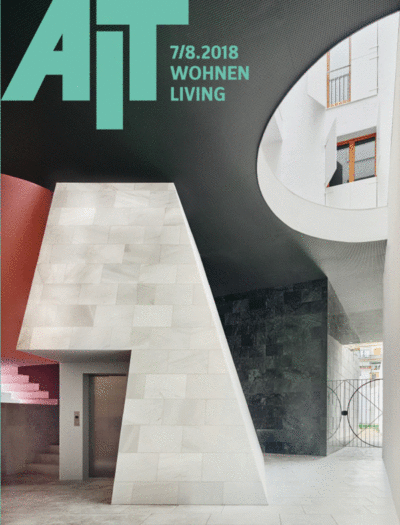
Issue 07/08 | 2018
Living
Dear Readers,
When it comes to housing, the main issue at the moment is shortage. Politics and the construction industry are fully committed to meeting this challenge. For architects and interior designers, it goes without saying that solutions must be found to meet these demands. The list of ideas is as varied as the requirements and the budgets: from Tiny Houses solutions to multi-storey apartment buildings and conversions to new and old buildings as well as annexes. We have collected a wealth of remarkable examples for this housing issue that do not look like shortage at all. The concept of transforming vacant office space
into attractive living space has already been implemented in various major German cities. Our author Rainer Müller has looked at a few of them and warmly recommends this effective form of conversion (p. 128). Subsequent densification is particularly appropriate wherever gaps in the urban space remain unused for years. How these can be filled is impressively demonstrated by a supplementary new building in London (p. 106), which only at second glance is not a reconstruction of the existing building, and by the conversion of an old metalworking shop in Stuttgart—or what was left of it—into two extremely comfortable
residential units (p. 142). And because shortage management is not our main concern anyway, we also show unusual living situations, not exactly inexpensive, but all the more inspiring—like the show apartment in Shanghai (p. 100) or Penthouse F in Vienna (p. 112). My visit to Villa Lemke in Berlin’s Alt-Hohenschönhausen district was also extremely inspiring (picture above). The last house designed by Mies van der Rohe in Germany before his emigration to the USA in 1938 was built in the Bauhaus style in the early 1930s and has served as an exhibition pavilion for modern art since 2002. And if you are planning a visit to the Architecture Biennale by November, don’t miss the opportunity to visit the island of San Giorgio Maggiore to see the Vatican’s first Biennale contribution (p. 11). If you can’t walk anymore, you will be helped (picture below). We wish you a sunny summer!
Best wishes
Petra Stephan, Dipl.-Ing.
Chief Editor
Architect
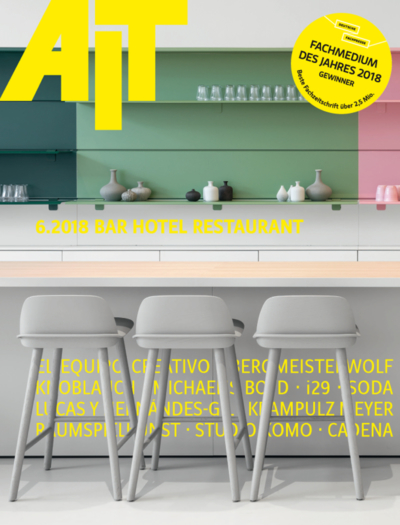
Issue 06 | 2018
BAR HOTEL RESTAURANT
Dear Readers,
we won!!! The German trade press has awarded AIT the title of best trade magazine 2018! On the next two pages we will tell you why we have been honoured for the 4th time and how we celebrated this occasion. Inspired by this news, we dedicated ourselves to the topic of our current issue, Bar Hotel Restaurant, to work through our impressions gathered at the Salone del Mobile in Milan (from page 32; on the left: “The Diner” installation by David Rockwell at Ventura Centrale). We not only took a closer look at the gastronomic projects, but also slept, bathed, ate there and – in the end – wrote about it. We visited St. Moritz, Büsum, Imst, Hamburg, Vienna, Offenburg, Stuttgart, Pontresina (picture below), and Amsterdam and have brought back first-hand information and impressions, which we have turned into an exciting mix of reports on remarkable bars, hotels, and restaurants (from page 84) for this issue. The first sunny days had an inspiring effect on the composition of the large special outdoor section (page 74). For the start of the summer season, we are presenting deckchairs, chairs, umbrellas, and luminaires for outdoors use in restaurants and cafés. Three very different representatives of our interior design/architectural profession are the focus of our series Mrs. Architect, Change of Perspective, and Apprenticeship at… Margarete Schütte-Lihotzky was much more than “just” the inventor of Frankfurt cuisine and has achieved astonishing things in her 103 years of life (page 52). Few interior designers are known from radio and television – but Eva Brenner can claim exactly that. Since studying interior design, she has been presenting television programmes and has told us about her work in front of the camera (page 56). Marie Menninger, an architecture student, is still at the very beginning of her career. One of her stations is an internship abroad at Kubota Bachmann in Paris (from page 60). Towards our editorial deadline, we had a very special experience in the “Ellington” in Berlin. On May 16th, we received the trophy for the best trade magazine 2018!
Best wishes
Petra Stephan, Dipl.-Ing.
Chief Editor
Architect

Issue 05 | 2018
PUBLIC BUILDINGS
Dear Readers,
the social significance of education is reflected not only in the number of childcare facilities and school buildings built, but also in their interior design quality. The furnishing and equipment of learning spaces, the spatial implementation of different learning structures and the integration into the urban context reflect the degree of seriousness with which a community cares for the next generation. That this should be on the agenda of all those involved in the educational mandate seems indispensable and self-evident. As a result, not only in rural areas, but also in urban areas in particular, new buildings have been built and converted for years. Especially in growth regions, however, the need for action is still greater than ever – as are the investments apparently made available for this purpose. Let’s tackle it, one would like to call out to the German decision-makers in particular, because if we consider the multitude of high-quality educational institutions as seismographs for the corresponding social relevance, our neighbouring countries Austria and Switzerland are doing significantly better in this respect. Our selection of children’s homes, day schools, educational centres, primary and elementary schools in this issue on the subject of public buildings is proof of this (page 84). That education should accompany people throughout their lives is not a new insight. But the approach of attracting the general population with particularly striking, identity-generating buildings seems to be. When culture takes place in spaceship-like structures, former prisons, converted renaissance castles or spectacularly colourful theatres (page 122), imparting knowledge is twice as much fun. The students of the Rising Star School in Hopley, a district of Harare in Zimbabwe, now obviously have fun learning. Engineers Without Borders supported the expansion of a school complex, as vividly reported by architects Kristina Egbers and Berta Franziska Bilger (page 128). And we had a lot of fun with our cultural training in Milan on the occasion of the Salone del Mobile – as our Milan pictures show!
Best wishes
Petra Stephan, Dipl.-Ing.
Chief Editor
Architect

Issue 04 | 2018
h3>OFFICE BUILDINGS
Dear Readers,
while at the beginning of the 20th century only about three percent of all employees in Germany earned their living with a desk job, this figure has meanwhile risen to 50 percent. There are 21 million “desk activists” – although many of them no longer necessarily work at the desk. Over the past ten years, office structures have undergone fundamental change as a result of digitisation. While the enthusiasm for open space concepts has long died down, new communication technologies enable working environments that are aimed at well-being and, ideally, provide every employee with a workstation that is appropriate for the task to be solved. The fact that employees now share desks, retreat into lounge and relaxation areas or meet in teams at long conference tables has also led to a rethink in the office furniture industry – to its advantage: for the fourth year in a row, the Office and Working Environment Industry Association recorded an increase in turnover. From page 85 on, we have compiled the latest products. Interior designers and architects can also be pleased: their tailor-made office concepts are in demand among clients who want to provide unconventional, identity-generating and flexible workplaces – not least to score points in the battle for experts and knowledge workers. Author and interior designer Susanne Leson (p. 143) believes that standard solutions are a thing of the past. You will not find among the office projects we selected (p. 100). Instead, you can explore over 70 pages full of ideas and find inspiration for new working environments, small startups, large headquarters and offices incorporating art and culture. The change from an individual office to a coworking space necessitates increased demands on acoustics. Concentrated work and communication need not be mutually exclusive once appropriate measures have been taken. Our special section on office acoustics (p. 90) provides all relevant information. We will be addressing the lighting topic in the next AIT issue after returning from Light + Building with the latest products (see photos). I promise!
Best wishes
Petra Stephan, Dipl.-Ing.
Chief Editor
Architect

Issue 03 | 2018
LIVING
Dear Readers,
For us, spring is every year dominated by a large number of trade fair visits. In the first few weeks of the year, one invitation after the other has probably arrived on your desk or in your e-mail inbox, too. In retrospect, however, one thing is for sure: So many direct contacts with friends, colleagues and business partners are only possible during an active trade fair visit, not to mention three-dimensional experiences on and around welldesigned trade fair stands – like at the Quadroskop (picture left) by Schmidhuber from Munich for Carpet Concept on the occasion of the Domotex trade fair! It goes without saying that we have returned home packed full of information about fair novelties to filter and process them for you. In this AIT issue you will find our furniture highlights
from imm cologne starting on page 28, everything about carpet innovations presented at Domotex starts on page 66 and textile discoveries from Heimtextil are featured from page 72 onwards. When selecting projects for the topic our current issue, Living, we once again found that there is an incredible number of outstanding examples for this. Whether it’s new buildings, conversions or extensions in Ljubljana, Turin, Zurich, Berlin, Stuttgart or Stockholm – the respectful and skilful use of materials and colours, the intelligent ideas for space-saving housing or careful considerations for the renovation of
historical monuments were the decisive factors for our selection (from page 84 on). The fact that Stuttgart is so strongly represented in this context surprised us only briefly, as we personally experience the density of construction sites in the capital of the “Häuslebauer” (home builders) every day on our way to the editorial office. In our new “Photo and Space” series (p. 130), we highlight completely different forms of living and show utopian examples from the 1960s and 1970s, photographed by Johanna Diehl. Of course, our columnists Dominik and Benjamin Reding have come up with something quite extraordinary (p. 56) on the subject of living – as always brilliant, but read for yourself!
Best wishes
Petra Stephan, Dipl.-Ing.
Chief Editor
Architect

Issue 01/02 | 2018
RETAIL AND PRESENTATION
Dear Readers,
Have you had a good start to the New Year? We hope so! For us it has started very dynamically: after four years we thought it was appropriate to refresh both the layout of AIT and its contents. And today, the first AIT issue in 2018 lies in front of you – with a modified, lighter graphic, larger images and additional contents. One of the new series is called “Mrs. Architect” (starting on p. 32) – does it sound familiar? Of course, we were not only inspired by the exhibition at the Deutsches Architekturmuseum (picture left and p. 22), we were even allowed to draw from the DAM curators’ archive and show you a personal and work history of our respected colleagues in each of the coming AIT issues. In the new series “Living in Icons” (from p. 36 on), we present buildings where architectural history can be experienced three-dimensionally and live. Under the heading of “Classics’ Birthday” (starting on p. 28), we are now celebrating products that – developed decades ago – are still part of the favourite repertoire of architects and interior designers today. And because we are of the opinion that good pictures often say more than many words, we now feature the new category “Photo and Space”. In keeping with the theme of our current issue, “Sales and Presentation”, we start with a series of photographs taken by photographer Anja Schlamann (from p. 122 on) and show archaic, unorthodox shop counters. And last but not least, we are once again asking architects and interior designers to help us choose the colours that characterise the three different sections of our magazine. For the first series, we were able to win Peter Ippolito and Gunter Fleitz from the Stuttgart-based Ippolito Fleitz Group (picture on the right). Apart from that, everything is as usual: a large selection of exceptional shop fitting and retail projects, corresponding products, current news from the architectural world – all of which have been selected, researched and reported by committed architecture and interior design colleagues. We would be pleased if you like the “new” AIT as much as we do!
Best wishes
Petra Stephan, Dipl.-Ing.
Chief Editor
Architect






